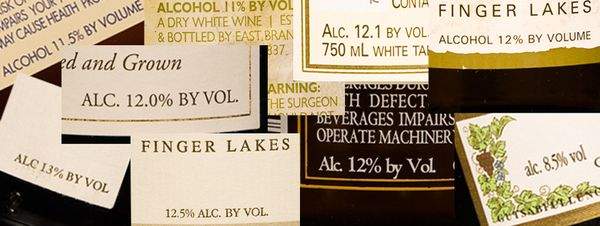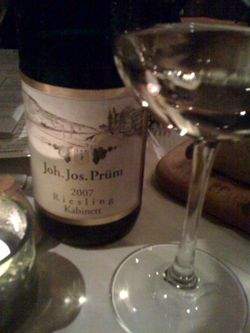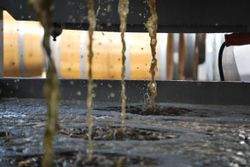 By Evan Dawson, Finger Lakes Editor
By Evan Dawson, Finger Lakes Editor
Photo montage by Morgan Dawson Photography
Are Finger Lakes wine producers insecure about alcohol?
It's a strange question, I realize. But it's one that came to mind when my wife and I were out to dinner recently. We ordered a bottle of Joh. Jos. Prum 2007 Riesling Kabinett from Germany's Mosel. The wine was beautiful — and it was only 9% alcohol by volume (ABV). Not long ago we enjoyed a Fritz Haag from Mosel that came in at 7% ABV. 
So I wondered: Why don't we see Finger Lakes rieslings at lower alcohol levels like their German counterparts?
Most Finger Lakes riesling checks in from 11% to 13% alcohol. There is certainly nothing inherently wrong with that. But I was curious to know if there is a marketing perception that American wine buyers recoil from wines under, say, 10% alcohol.
First, it helps to understand why Mosel riesling generally brings lower alcohol. For the answer, I turned to a German — winemaker Johannes Reinhardt of Anthony Road Wine Company. Johannes points out the following:
- Germans can not, by law, add bags of sugar in the winemaking process (at least not for the better rieslings). They live with the natural sugar of the grapes. This can result in less overall sugar to work with, thus less alcohol that can be created.
- Germans tend not to take acid out, even if the acidity is severe. So to counteract the extreme acids, they leave more sugar, choosing to ferment less to alcohol.
So far so good. But you might be saying, "American winemakers add bags of sugar?"
Sometimes, yes. They can do it to increase the alcohol of a wine. They can also ferment all of the natural sugar into alcohol and then "back-sweeten" to increase the sugar content in the finished wine. Not everyone does this, but it happens, and winemaker Chris Stamp of Lakewood Vineyards on Seneca Lake thinks some winemakers add sugar simply to make sure there's a higher ABV.
"Why throw sugar in just to get alcohol up?" Stamp recently asked as he evaluated the 2009 riesling at Lakewood, which came in between 18 and 20 brix (lower than usual). "We don't need bags of Domino's Sugar to make a quality riesling."
Stamp is not trying to sound flippant or edgy; he's one of the most soft-spoken and courteous winemakers you'll meet. But he's also one of the few who will offer a Finger Lakes riesling with an ABV that looks a lot more like Mosel. This year, he expects the Lakewood Riesling to finish around 9% ABV while the Lakewood Dry Riesling will end up around 10.5% ABV. In cooler growing years Stamp believes the more natural result is a lower-alcohol riesling.
"Instead of trying to mold the wine into something it's not meant to be, we take a different approach," he explained. "Different years call for different styles of wine. 2007 demanded higher alcohol wines because the grapes came in with so much sugar. Of course, it's easy to decide what kind of riesling you're going to make before the grapes come in. But sometimes if you've already decided, you have to force things. Maybe I'm getting older, but I prefer a more natural approach."
Up the road at Hermann J. Wiemer, winemaker Fred Merwarth agrees. "I think there probably is a perception in this region that the alcohol needs to be at a certain level, but that's wrong," Merwarth said during a recent break in harvesting riesling. "We have a late harvest wine that finishes around 9% alcohol in most years, and I don't think we've ever had a customer question it."
But Fox Run winemaker Peter Bell offers a note of caution. "These German rieslings can really taste good with a few years of bottle age. But most Finger Lakes rieslings are drunk very young." He goes on to say that a low-alcohol riesling without much bottle age can taste "startlingly non-vinous."
And over on Cayuga Lake, Sheldrake Point general manager Bob Madill notes that Germans might be using "wild fermentations or weaker yeasts. If you harvest a 19 brix grape, and assume (a lower conversion of alcohol than in the Finger Lakes), then the riesling if fermented to a residual sugar of 2.5% would have an alcohol level of about 8.25 to 8.5%. Riper and more likely to be balanced. So, depending on the season, harvest and fermentation objectives, it might be possible to produce a ripe and balanced Finger Lakes riesling at lower levels of alcohol."
Got all that?
The good news is that more producers seem to be having thoughtful conversations about how to handle the wildly varying harvests in the Finger Lakes. Can consumers tell the difference between a riesling with only natural sugars and a riesling sweetened with Domino's sugar? That might be better answered by our Science Editor here at the New York Cork Report.
But purists will gravitate toward more natural wines, like those from Lakewood and Wiemer.
At Anthony Road, Reinhardt is experimenting with a half dozen trials with the intention of creating a lower alcohol riesling this year. He stresses that lower alcohol rieslings should come from "the best fruit from well established vineyard sites."
And what does it all mean? Just that a wine region that already produces some world-class rieslings is having the kinds of conversations that will inevitably lead to better understanding of what the area offers. 2009 will produce naturally lower alcohols. There is no right percentage for alcohol — ABV is not as easy as ABC or even 12.3.
